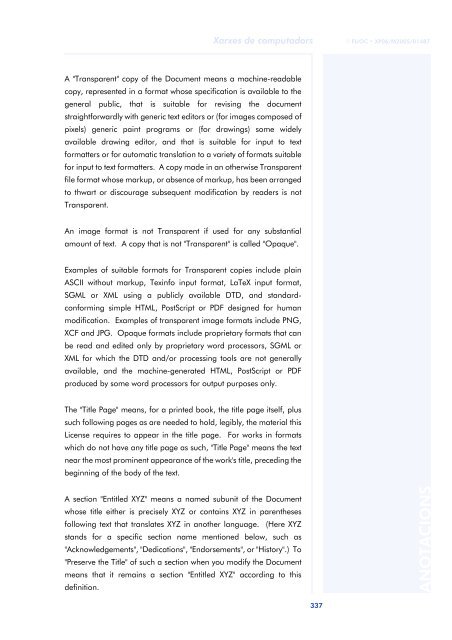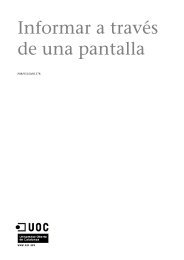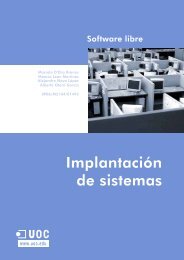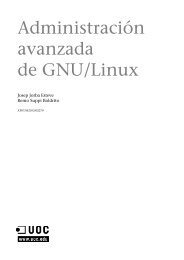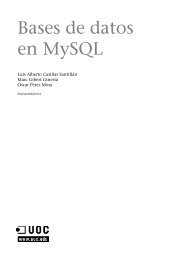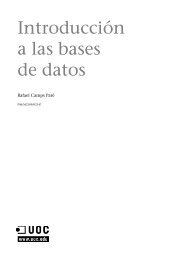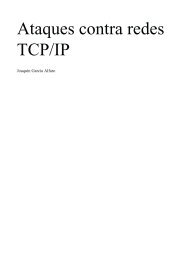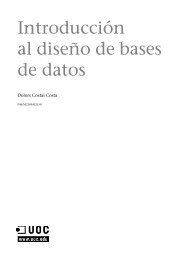- Page 1 and 2:
José María Barceló Ordinas Jordi
- Page 3 and 4:
Índex Xarxes de computadors Agraï
- Page 5 and 6:
Xarxes de computadors 12. Protocols
- Page 7:
Xarxes de computadors 19.5.3. Missa
- Page 11 and 12:
Introducció Xarxes de computadors
- Page 13:
Xarxes de computadors diferents. Aq
- Page 16 and 17:
© FUOC • XP06/M2005/01487 ANOTAC
- Page 19 and 20:
1. Breu història de les comunicaci
- Page 21 and 22:
Figura 2. Xarxes de computadors D
- Page 23 and 24:
Xarxes de computadors matiu, s’ha
- Page 25 and 26:
Xarxes de computadors També es van
- Page 27 and 28:
Xarxes de computadors telefònica q
- Page 29 and 30:
Xarxes de computadors tablir el cam
- Page 31 and 32:
Xarxes de computadors Convé consid
- Page 33 and 34:
Xarxes de computadors • Una xarxa
- Page 35 and 36:
1.5. La banda ampla Xarxes de compu
- Page 37 and 38:
2. Arquitectures de protocols: el m
- Page 39 and 40:
Xarxes de computadors formàtic, ub
- Page 41 and 42:
2.4. Els set nivells del model OSI
- Page 43 and 44:
Xarxes de computadors punts de vist
- Page 45:
Xarxes de computadors port a l’ap
- Page 49 and 50:
3. Les xarxes d’àrea local Xarxe
- Page 51:
Xarxes de computadors Com es pot ve
- Page 54 and 55:
© FUOC • XP06/M2005/01487 ANOTAC
- Page 56 and 57:
© FUOC • XP06/M2005/01487 ANOTAC
- Page 59 and 60:
5. Cablatge estructurat Xarxes de c
- Page 61:
Xarxes de computadors Els costos d
- Page 64 and 65:
© FUOC • XP06/M2005/01487 ANOTAC
- Page 66 and 67:
© FUOC • XP06/M2005/01487 ANOTAC
- Page 69 and 70:
7. Estructura de protocols a Intern
- Page 71 and 72:
7.1. Protocols d’Internet Xarxes
- Page 73:
Xarxes de computadors Imaginem que
- Page 76 and 77:
© FUOC • XP06/M2005/01487 ANOTAC
- Page 78 and 79:
© FUOC • XP06/M2005/01487 ANOTAC
- Page 80 and 81:
© FUOC • XP06/M2005/01487 ANOTAC
- Page 82 and 83:
© FUOC • XP06/M2005/01487 ANOTAC
- Page 84 and 85:
© FUOC • XP06/M2005/01487 ANOTAC
- Page 86 and 87:
© FUOC • XP06/M2005/01487 ANOTAC
- Page 88 and 89:
© FUOC • XP06/M2005/01487 ANOTAC
- Page 90 and 91:
© FUOC • XP06/M2005/01487 ANOTAC
- Page 92 and 93:
© FUOC • XP06/M2005/01487 ANOTAC
- Page 94 and 95:
© FUOC • XP06/M2005/01487 ANOTAC
- Page 96 and 97:
© FUOC • XP06/M2005/01487 ANOTAC
- Page 99 and 100:
Xarxes de computadors 10. L’ICMP
- Page 101 and 102:
Xarxes de computadors ració de mis
- Page 103 and 104:
Xarxes de computadors Cada encamina
- Page 105 and 106:
Xarxes de computadors El programa t
- Page 107 and 108:
11. Xarxes d’accés a Internet Xa
- Page 109 and 110:
Xarxes de computadors • Protocols
- Page 111 and 112:
Xarxes de computadors Tanmateix, hi
- Page 113 and 114:
Xarxes de computadors En general, l
- Page 115 and 116:
11.3.1. Format de la trama Ethernet
- Page 117 and 118:
Xarxes de computadors Les trames qu
- Page 119 and 120:
Xarxes de computadors aquesta xarxa
- Page 121:
Xarxes de computadors als quals est
- Page 124 and 125:
© FUOC • XP06/M2005/01487 ANOTAC
- Page 126 and 127:
© FUOC • XP06/M2005/01487 ANOTAC
- Page 128 and 129:
© FUOC • XP06/M2005/01487 ANOTAC
- Page 131 and 132:
14. El TCP (transmission control pr
- Page 133 and 134:
14.2. Format del segment TCP Xarxes
- Page 135 and 136:
Xarxes de computadors e) El camp Lo
- Page 137 and 138:
Xarxes de computadors j) El camp Ur
- Page 139 and 140:
Xarxes de computadors Considerem qu
- Page 141 and 142:
3. Reconeixement de la connexió Xa
- Page 143 and 144:
Xarxes de computadors En una connex
- Page 145 and 146:
Xarxes de computadors 2. argos envi
- Page 147 and 148:
Xarxes de computadors La fase d’e
- Page 149 and 150:
Xarxes de computadors ent podria ex
- Page 151 and 152:
Xarxes de computadors Mentre que el
- Page 153 and 154:
Xarxes de computadors 3. El TCP nom
- Page 155 and 156:
Xarxes de computadors Les línies q
- Page 157:
Xarxes de computadors transmet un s
- Page 161 and 162:
15. El model client/servidor Xarxes
- Page 163 and 164:
• Múltiples servidors: Figura 74
- Page 165:
Xarxes de computadors Jabber, veur
- Page 168 and 169:
© FUOC • XP06/M2005/01487 ANOTAC
- Page 170 and 171:
© FUOC • XP06/M2005/01487 ANOTAC
- Page 172 and 173:
© FUOC • XP06/M2005/01487 ANOTAC
- Page 174 and 175:
© FUOC • XP06/M2005/01487 ANOTAC
- Page 176 and 177:
© FUOC • XP06/M2005/01487 ANOTAC
- Page 178 and 179:
© FUOC • XP06/M2005/01487 ANOTAC
- Page 180 and 181:
© FUOC • XP06/M2005/01487 ANOTAC
- Page 182 and 183:
© FUOC • XP06/M2005/01487 ANOTAC
- Page 184 and 185:
© FUOC • XP06/M2005/01487 ANOTAC
- Page 186 and 187:
© FUOC • XP06/M2005/01487 ANOTAC
- Page 189 and 190:
17. Serveis bàsics d’Internet 17
- Page 191 and 192:
Xarxes de computadors b) Hi ha tres
- Page 193 and 194:
Xarxes de computadors Els quatre co
- Page 195 and 196:
Xarxes de computadors • AO (Abort
- Page 197 and 198:
Xarxes de computadors 17.2. Termina
- Page 199 and 200:
Xarxes de computadors • Si no dis
- Page 201 and 202:
Xarxes de computadors • Si és ze
- Page 203:
Xarxes de computadors • En el seg
- Page 206 and 207:
© FUOC • XP06/M2005/01487 ANOTAC
- Page 208 and 209:
© FUOC • XP06/M2005/01487 ANOTAC
- Page 210 and 211:
© FUOC • XP06/M2005/01487 ANOTAC
- Page 212 and 213:
© FUOC • XP06/M2005/01487 ANOTAC
- Page 214 and 215:
© FUOC • XP06/M2005/01487 ANOTAC
- Page 216 and 217:
© FUOC • XP06/M2005/01487 ANOTAC
- Page 218 and 219:
© FUOC • XP06/M2005/01487 ANOTAC
- Page 220 and 221:
© FUOC • XP06/M2005/01487 ANOTAC
- Page 222 and 223:
© FUOC • XP06/M2005/01487 ANOTAC
- Page 224 and 225:
© FUOC • XP06/M2005/01487 ANOTAC
- Page 226 and 227:
© FUOC • XP06/M2005/01487 ANOTAC
- Page 228 and 229:
© FUOC • XP06/M2005/01487 ANOTAC
- Page 230 and 231:
© FUOC • XP06/M2005/01487 ANOTAC
- Page 232 and 233:
© FUOC • XP06/M2005/01487 ANOTAC
- Page 234 and 235:
© FUOC • XP06/M2005/01487 ANOTAC
- Page 236 and 237:
© FUOC • XP06/M2005/01487 ANOTAC
- Page 238 and 239:
© FUOC • XP06/M2005/01487 ANOTAC
- Page 240 and 241:
© FUOC • XP06/M2005/01487 ANOTAC
- Page 242 and 243:
© FUOC • XP06/M2005/01487 ANOTAC
- Page 244 and 245:
© FUOC • XP06/M2005/01487 211 Es
- Page 246 and 247:
© FUOC • XP06/M2005/01487 ANOTAC
- Page 248 and 249:
© FUOC • XP06/M2005/01487 ANOTAC
- Page 250 and 251:
© FUOC • XP06/M2005/01487 ANOTAC
- Page 252 and 253:
© FUOC • XP06/M2005/01487 ANOTAC
- Page 254 and 255:
© FUOC • XP06/M2005/01487 ANOTAC
- Page 256 and 257:
© FUOC • XP06/M2005/01487 ANOTAC
- Page 258 and 259:
© FUOC • XP06/M2005/01487 ANOTAC
- Page 260 and 261:
© FUOC • XP06/M2005/01487 ANOTAC
- Page 262 and 263:
© FUOC • XP06/M2005/01487 ANOTAC
- Page 264 and 265:
© FUOC • XP06/M2005/01487 ANOTAC
- Page 266 and 267:
© FUOC • XP06/M2005/01487 ANOTAC
- Page 268 and 269:
© FUOC • XP06/M2005/01487 ANOTAC
- Page 270 and 271:
© FUOC • XP06/M2005/01487 ANOTAC
- Page 272 and 273:
© FUOC • XP06/M2005/01487 ANOTAC
- Page 274 and 275:
© FUOC • XP06/M2005/01487 ANOTAC
- Page 276 and 277:
© FUOC • XP06/M2005/01487 ANOTAC
- Page 278 and 279:
© FUOC • XP06/M2005/01487 ANOTAC
- Page 280 and 281:
© FUOC • XP06/M2005/01487 ANOTAC
- Page 282 and 283:
© FUOC • XP06/M2005/01487 ANOTAC
- Page 284 and 285:
© FUOC • XP06/M2005/01487 ANOTAC
- Page 286 and 287: © FUOC • XP06/M2005/01487 ANOTAC
- Page 288 and 289: © FUOC • XP06/M2005/01487 ANOTAC
- Page 290 and 291: © FUOC • XP06/M2005/01487 ANOTAC
- Page 293 and 294: 21. Servei hipermèdia: WWW 21.1. D
- Page 295 and 296: Xarxes de computadors que permet de
- Page 297 and 298: Xarxes de computadors nom complet d
- Page 299 and 300: Xarxes de computadors Per a obtenir
- Page 301 and 302: La sintaxi de les línies d’estat
- Page 303 and 304: Capçaleres dels missatges HTTP Xar
- Page 305 and 306: Xarxes de computadors e) Expires: d
- Page 307 and 308: Xarxes de computadors un accés no
- Page 309 and 310: 21.3.3. Mètodes del servei HTTP El
- Page 311 and 312: Xarxes de computadors En la configu
- Page 313 and 314: 22. Missatgeria instantània Xarxes
- Page 315: 22.1.2. AIM Xarxes de computadors A
- Page 318 and 319: © FUOC • XP06/M2005/01487 ANOTAC
- Page 320 and 321: © FUOC • XP06/M2005/01487 ANOTAC
- Page 323: Bibliografia Xarxes de computadors
- Page 326 and 327: © FUOC • XP06/M2005/01487 ANOTAC
- Page 328 and 329: © FUOC • XP06/M2005/01487 ANOTAC
- Page 330 and 331: © FUOC • XP06/M2005/01487 ANOTAC
- Page 332 and 333: © FUOC • XP06/M2005/01487 ANOTAC
- Page 334 and 335: © FUOC • XP06/M2005/01487 ANOTAC
- Page 338 and 339: © FUOC • XP06/M2005/01487 ANOTAC
- Page 340 and 341: © FUOC • XP06/M2005/01487 ANOTAC
- Page 342 and 343: © FUOC • XP06/M2005/01487 ANOTAC
- Page 344 and 345: © FUOC • XP06/M2005/01487 ANOTAC


